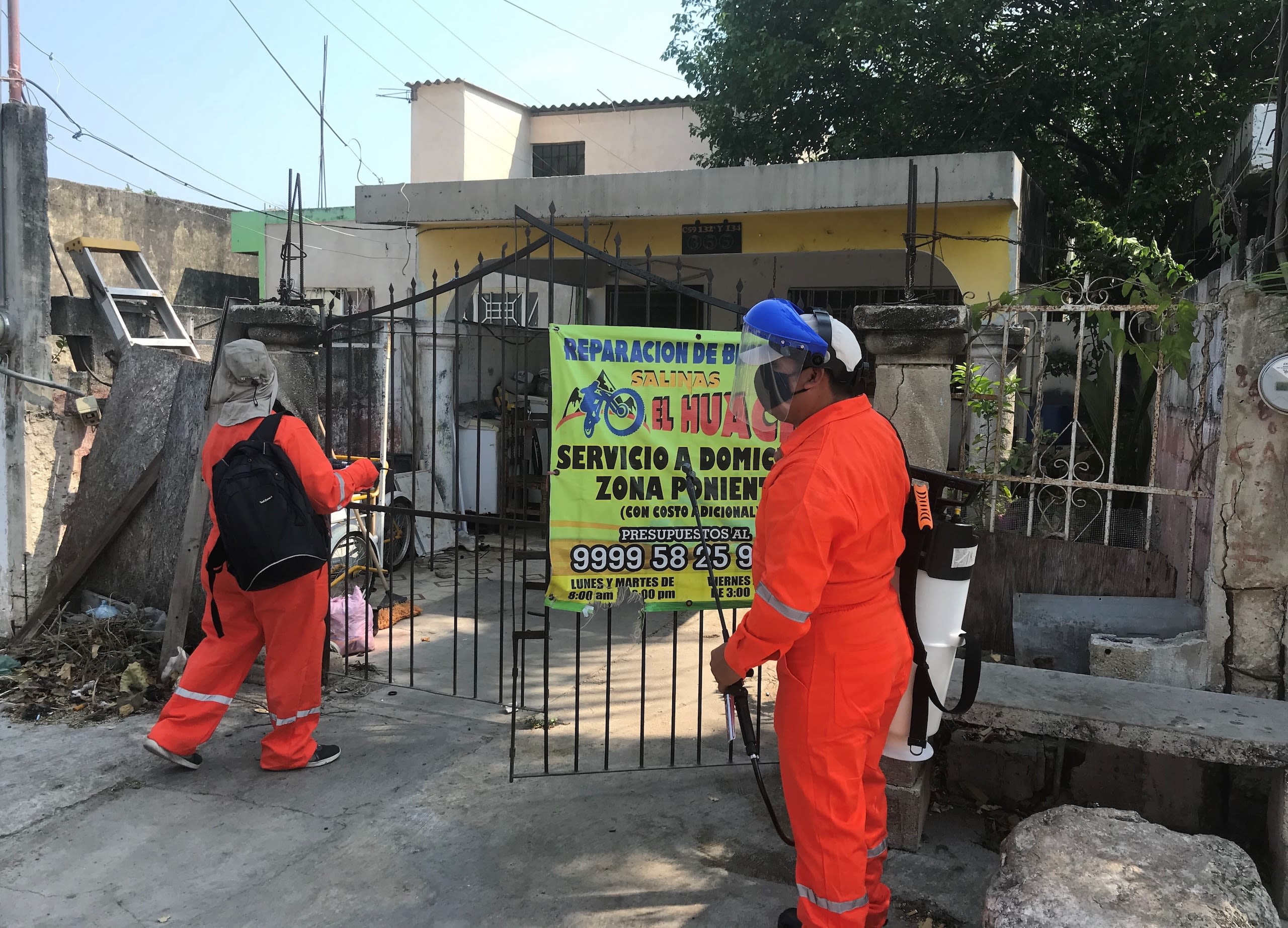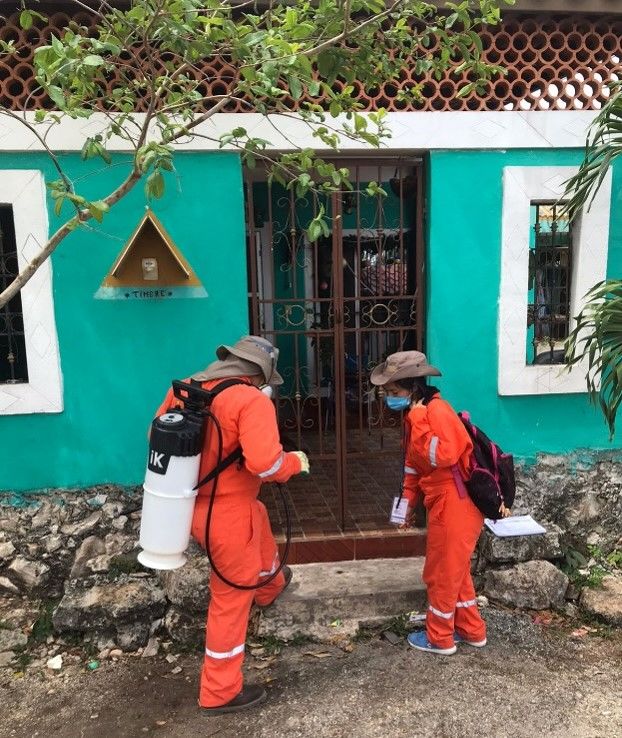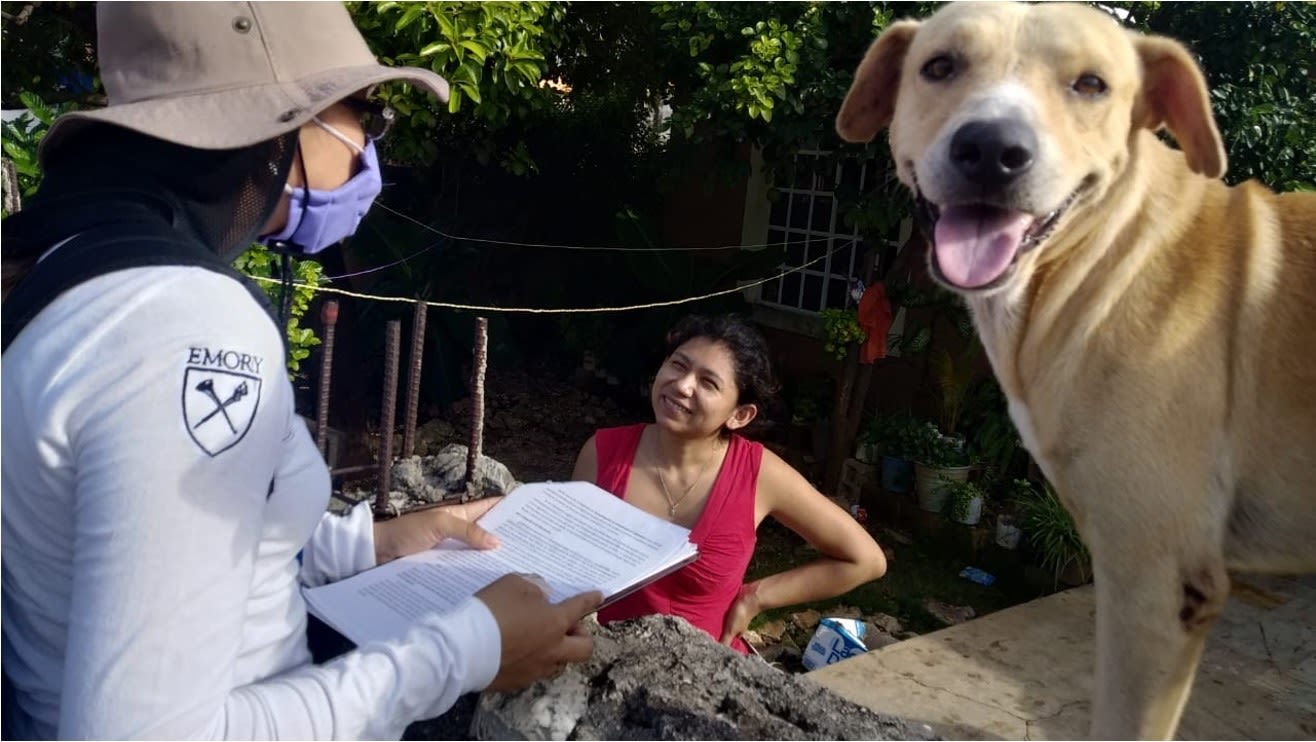Major Test of New Method to Control Dengue Mosquito Shows Public Health Benefit
Targeted indoor residual spraying yields community-wide reduction in disease cases

A novel disease prevention strategy — targeting a mosquito that spreads the dengue virus — significantly reduces both the mosquito numbers and cases of disease across a community, finds a major new study.
New England Journal of Medicine published the results of the large, randomized clinical trial — considered the gold standard for evaluating the effectiveness of an intervention — led by Emory University. The research was conducted in Merida, a city of one million in the Mexican state of the Yucatan, through a close collaboration with the Autonomous University of the Yucatan, the Yucatan Ministry of Health and the Federal Ministry of Health of Mexico.
The project tested an intervention that previous Emory research found promising: Targeted indoor residual spraying of insecticide, or TIRS, conducted before an outbreak occurs. The method is aimed at a particular species of mosquito, Aedes aegypti, that is perfectly adapted to live with humans in an urban setting.
“Our study showed that the TIRS method reduced numbers of these mosquitos by 6o% for a period of six months,” says Gonzalo Vazquez-Prokopec, senior author of the study and Emory professor of environmental sciences. “The results also quantified a 24% mean reduction community-wide in cases of dengue fever, even in the context of a record-breaking outbreak of dengue in Merida.”
"This project was a major undertaking," says Natalie Dean, first author of the study and associate professor of biostatistics and bioinformatics and epidemiology in Emory's Rollins School of Public Health. "The team conduced a well-executed and powerful study, combining epidemiology and entomology, to test the efficacy of an intervention for a mosquito-borne disease over years of different outbreak seasons."
There is little precedent, she notes, for such a comprehensive approach to testing the effectiveness of public health interventions for Aedes-borne diseases.
Natalie Dean, an expert in biostatistics and epidemiology, is first author of the study, and Gonzalo Vazquez-Prokopec, an expert in mosquito-borne diseases, is senior author. (Photos courtesy of Dean and Vazquez-Prokopec)
Natalie Dean, an expert in biostatistics and epidemiology, is first author of the study, and Gonzalo Vazquez-Prokopec, an expert in mosquito-borne diseases, is senior author. (Photos courtesy of Dean and Vazquez-Prokopec)
Emory co-authors include Lance Waller, professor of biostatistics at Rollins School of Public Health, and Matthew Collins, assistant professor in the School of Medicine Division of Infectious Diseases.
Co-author Pablo Manrique-Saide, professor of biology at the Autonomous University of Yucatan, led efforts on the ground in Mexico.
The National Institutes of Health's Division of Microbiology and Infectious Diseases funded the ambitious, five-year project as part of a quest to reduce viral infections spread by the Aedes aegypti mosquito. The mosquito is notorious for its ability to carry an array of dangerous viral pathogens, giving it the potential to spark outbreaks of chikungunya, yellow fever and Zika.
Read more about the Merida study here.
Dengue, also known as break-bone fever due to the debilitating pain it causes, is the most prevalent disease spread by Aedes to people, causing an estimated 100-400 million infections globally each year. In severe cases, dengue can be fatal. Outbreaks are most common in tropical and subtropical regions with large areas of densely packed, substandard housing, where Aedes tends to proliferate.
Most cases of dengue are asymptomatic, and the disease is so common only a small fraction get reported to the World Health Organization (WHO). In 2023, WHO recorded a historic high of 6.5 million dengue cases globally, including more than 7,300 dengue-related deaths.
In advance of the rainy season, local public health officials sprayed a long-lasting insecticide safe for indoor use, targeted to areas where the Aedes mosquito prefers to hang out.
In advance of the rainy season, local public health officials sprayed a long-lasting insecticide safe for indoor use, targeted to areas where the Aedes mosquito prefers to hang out.
For nearly two decades, Vazquez-Prokopec — a leading expert on diseases spread by mosquitos, ticks and other vectors — has tracked outbreaks spread by bites from Aedes in various parts of the world. He uses global information systems to record and map the movements of people, combined with blood tests to determine if they carry one of the viruses. He also maps the locations of the Aedes mosquito, studying its behaviors and whether it is developing resistance to a particular pesticide.
The "couch potato" of mosquitos, Aedes' preferred habitat is inside homes, where it rests behind and beneath furniture and at the bases of walls. It feeds almost exclusively on the blood of people and is a poor flyer, with a range of just 100 meters.
These behaviors mean most of these mosquitos survive when public health departments spray insecticide up and down streets — the standard response to an outbreak of dengue or other Aedes-borne diseases.
Vazquez-Prokopec and colleagues began investigating the novel approach of indoor spraying of a long-lasting — or residual — insecticide, safe for use in homes. Spraying in homes is time consuming and labor intensive, making it impossible to cover an entire city. Instead, his team uses a targeted approach — treating homes in neighborhoods where dengue outbreaks have repeatedly occurred, so-called "hotspots."
The method, dubbed TIRS, is applied as a preventative measure months before outbreaks typically occur.
The researchers had previously established that the TIRS method significantly knocked down Aedes populations in dengue hotspots of Merida. The NIH grant allowed them to also test the impact of TIRS on disease incidence, using the gold standard of a randomized clinical trial.
"We believe our work serves as a model for how to conduct field research during a pandemic," Vazquez-Prokopec says.
"We believe our work serves as a model for how to conduct field research during a pandemic," Vazquez-Prokopec says.
The project launched in 2020 amid the COVID-19 pandemic, making the ambitious trial even more challenging. Working remotely over Zoom, Emory scientists trained a team of 80 people from the University of Yucatan — including nurses, anthropologists, social workers and others — to go into the field for the recruitment phase. This ground crew adhered to strict COVID-19 safety protocol.
Going door-to-door, team members enrolled nearly 5,000 children, ages two to 15, for the study, along with thousands more households. Altogether, the trial included 33,000 homes within 50 clusters of city blocks that included hotspots for dengue fever.
Over the course of the study, local health department officials treated some of the homes with a long-lasting insecticide, weeks in advance of the rainy season when mosquito activity peaks. Houses not receiving treatment served as controls.
From 2021 to 2024, the research team regularly contacted families with children participating in the study for medical monitoring of symptoms of an Aedes-borne disease. Blood draws and analyses were required to confirm a child's infection status.
"Our close partnership with our colleagues in Mexico allowed us to mount and maintain such a large study over three years," Vazquez-Prokopec says.
"We believe our work serves as a model for how to conduct field research during a pandemic," he adds.
A member of the project's field team, left, explains the study to a resident of Merida as the resident's dog looks on.
A member of the project's field team, left, explains the study to a resident of Merida as the resident's dog looks on.
The results of the Herculean effort confirmed that TIRS significantly reduces the Aedes population as well as the disease burden in a community.
Over the course of the study, 422 Aedes-borne disease cases were confirmed in children, almost exclusively dengue cases, with the majority occurring in 2023, during the record-setting outbreak of the disease globally. (Mexico's Ministry of Health confirmed nearly 55,000 cases of dengue that year, with 47% classified as severe dengue, setting a historical record for cases in the country.)
TIRS yielded no significant impact on children's cases of dengue within the Merida study cohort, the researchers found.
Analysis of Ministry of Health surveillance data, however, encompassing all community members within the study area, showed TIRS treatment reduced dengue cases by 24% in the community overall.
The surveillance data captured older populations, which are more likely to experience their second or third dengue infection. These infections are more likely to be symptomatic.
Other factors that may have influenced the variation in data for different age groups include differences in mobility patterns. Dengue cases declined during 2020-2021, when people were less mobile during the early stages of the COVID-19 pandemic, followed by increases in mobility, perhaps opening the door to the record-breaking surge of dengue.
"Mosquitos are just one factor in a complicated story," Vazquez-Prokopec says.
Dengue and other Aedes-borne diseases are extremely complex. Dengue, for instance, comes in four different viral serotypes and is mainly spread by people who are asymptomatic. Over the course of their lives, people can become immune to one serotype and not another. In 2023, Mexico saw the reemergence of the DNV-3 serotype, which had not circulated in a decade.
"Our study is one of the very few random-controlled trials to show a significant impact for an intervention against an Aedes-borne disease," Vazquez-Prokopec says. "We are continuing to evaluate the TIRS approach to learn how it may be further improved. We want our work to have lasting benefits for the many people affected by dengue throughout the world."
Many tools are needed for the control of the Aedes mosquito, he adds, as a warming world and rapid urbanization hold the potential to fuel more record-breaking outbreaks of the diseases it spreads.
Co-authors among the project's international consortium include scientists from University of Florida; University of Central Florida; University of Washington; Fred Hutchinson Cancer Center; U.S. Centers for Disease Control and Prevention; Secretary of Health, Mexico City, Mexico; National Institute of Public Health in Cuernavaca, Mexico and Ministry of Health, Jerusalem, Israel.
Story by Carol Clark. Photos courtesy of Vazquez-Prokopec lab.
To learn more about Emory, please visit:
Emory News Center
Emory University





